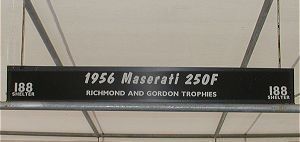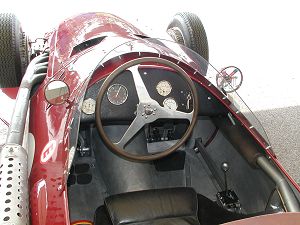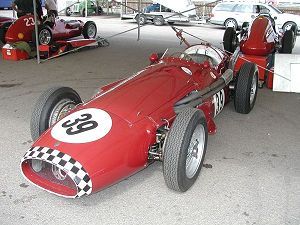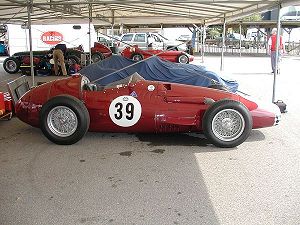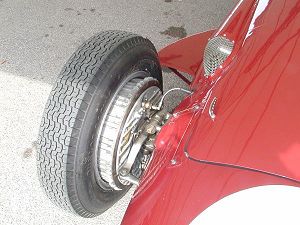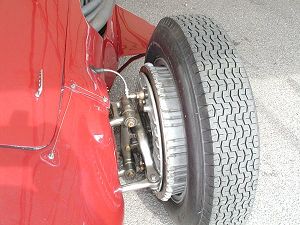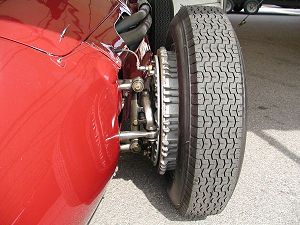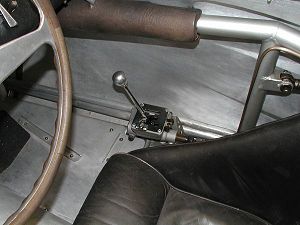In spite of having the most successful Grand Prix car of 1957 with four victories in the Argentine, Monaco, French and German Grand Prix, Maserati officially withdrew from motor racing in 1958. Signor Orsi, head of Maserati, blamed high costs and the introduction of the 3-litre limit for sports/racing cars which rendered their 4.5-litre V8 obsolete overnight. The 250F is unusual in that following the introduction of the new 2.5-litre formula it not only participated in the opening race of the new formula in 1954 but made its final appearance driven by privateer Bob Drake, in the final race for that formula at the United States GP of 1960. From its introduction in 1954 to its World Championship winning year in 1957 and on to that final race it remained the same basic design and can claim to have been victorious on its debut at the 1954 Argentine GP with Fangio at the wheel.
Maserati had always built cars not only for their factory team but also for its privateer customers and between 1954 and 1958 some 34 cars were built. Developed from the A6GCM 2-litre 6-cyl engine, the 2.5-litre engine of the 250F was largely the work of Gioacchino Colombo and Vittorio Bellentani, who put in a great deal of work on the cylinder heads raising power output to some 240 bhp @ 7400 rpm.
In 1954 Colombo left Maserati to join Bugatti and development was placed in the hands of Giulio Alfieri who brought the model to a higher pitch of efficiency. The chassis, drastically lightened by using a small diameter welded multi-tubed steel was designed by Valerio Colotti. Front suspension was independent by means of unequal length double wishbones with coil springs. Rear suspension was de Dion type with a transverse leaf spring mounted in front of the rear axle with Houdaille double-acting shock absorbers. Power from the V6 engine was transmitted through a multi-plate clutch on the rear of crankshaft and then by an open propellor shaft to the rear axle/gearbox assembly. Braking was by finned drum brakes all-round. A four-speed rear mounted gearbox was later replaced with a five-speed box.
Over the years, the 250F had evolved into the Championship winning 'light-weight' car of 1957, the model most endeared by its drivers: its chassis had been lightened and lowered by the use of smaller diameter and thinner gauge tubing, braking was continually improved by the use of larger and wider drums together with the addition of extra cooling fins and the bodywork redesigned with the multi louvred panels replaced with smoother and sleeker panels containing fewer vents. The twin overhead camshaft 2,493 cc V6 engine was now developing 270 bhp @ 8000 rpm.
At the 1957 German Grand Prix at Nürburgring Fangio in a 250F wrote one of the great chapters in Maserati motor racing history. Expecting excessive tyre wear, Maserati started the race with their cars on half empty fuel tanks deciding to push them right from the start with a view to changing tyres during the fuel stop. By lap 12 Fangio had built himself a lead of some 30 seconds when he pulled into the pits for fuel and fresh tyres. A disastrously slow stop meant that by the time he left the pits not only had he lost the lead but he now trailed the leaders, Mike Hawthorn and Peter Collins in the two Ferraris, by some fifty seconds. With a heavy fuel load and new tyres Fangio failed to make any impression on the leaders during the next three laps of the 14-mile circuit. The Ferrari pit thinking Fangio was in trouble signalled their drivers to ease up whilst from the Maserati pit came instructions to press hard. After a series of record breaking laps, which produced the first 90 mph lap at the Nürburgring, Fangio had reduced the lead to 33 seconds by the end of lap 16, three laps later the lead was down to 14 seconds and by the end of lap 20 he was only a couple of second behind the leaders by which time I understand new orders were issued to the Ferrari drivers. On the following lap he passed both the Ferraris and went on to win the race by 3.6 seconds.
Notable privateers who drove the 250F include Sergio Mantovani, Roberto Mieres, Prince Bira, Roy Salvadori, Horace Gould, Bruce Halford, Carlos Menditgeguy, Harry Schell, Francesco Godia-Sales, Onofre Marimon and the only female driver of a 250F Maria-Teresa de Filippis. |
